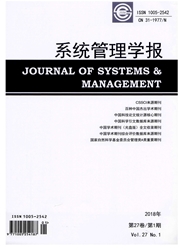

 中文摘要:
中文摘要:
RFID(无线射频)技术作为一种有效的技术手段,正越来越多地被应用于提高供应链的绩效。如何协调投资RFID技术的成本及供应链的收益是迫切需要解决的问题。以1个生产商和2个零售商组成的两级供应链为研究对象,同时考虑零售店内商品的错放和耗损两种情况对零售商最优订货量的影响,构建了零售商之间的竞争博弈价格模型,分析了商品的错放率和耗损率对其定价的影响。在此基础上,分析引入RFID技术消除商品的错放和耗损给供应链带来的收益,剖析了采用RFID技术后对供应链及其成员收益的影响,导出可使供应链收益提高的RFID成本约束条件,并证明零售商采用线性转移支付策略可实现供应链成员收益的Pareto改进。最后,通过数值算例对结论进行了验证。
 英文摘要:
英文摘要:
RFID (Radio Frequency Identification), as an effective technology, is increasingly being used in improving the supply chain performance. We study the supply chain with one manufacturer and two retailers, which adopt RFID technology. We build a competitive pricing game model between two retailers, and calculate the price that maintains high profit for supply chain parties, considering the misplaced and spoiled products. The objective is to study the effect of misplaced and spoiled products on profit of supply chain parties and discuss the cost condition of RFID technology leading to the improvement of the supply chain profit. We show when the retailer uses linear transfer payment strategy, the Pareto improvement of the supply chain profits can be increased. The conclusion is validated through a numericalexample.
 同期刊论文项目
同期刊论文项目
 同项目期刊论文
同项目期刊论文
 Production decisions in a hybrid manufacturing-remanufacturing system with carbon cap and trade mech
Production decisions in a hybrid manufacturing-remanufacturing system with carbon cap and trade mech Misplaced Inventory and Lead-Time in the Supply Chain: Analysis of Decision-Making on RFID Investmen
Misplaced Inventory and Lead-Time in the Supply Chain: Analysis of Decision-Making on RFID Investmen 期刊信息
期刊信息
